In March, we initiated our new insights series called "Embracing end-to-end revenue management in medtech and diagnostics." Our introductory blog discussed the importance of Revenue Management Systems (RMS) for medtech and diagnostics companies aiming to adapt to economic fluctuations and achieve commercial excellence. In this second chapter of the series, we now deep dive into the first of the four pillars of our RMS framework — lead and opportunity management.
Lead and opportunity management is an integral part of E2E revenue management. Effective lead and opportunity management process supported by Marketing Automation suites (MA) and Customer Relationship Management (CRM) helps organizations systematically identify, prioritize, and pursue business opportunities, enabling profitable growth.
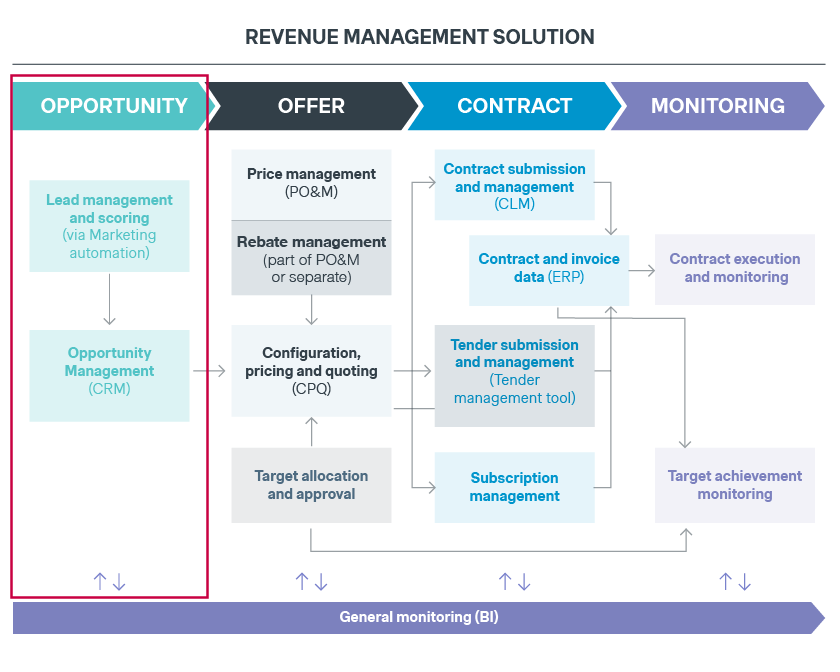
Why is an integrated lead and opportunity management important?
The synergy between lead and opportunity management becomes particularly evident when integrated with a robust revenue management system. It not only streamlines sales processes but also enhances collaboration among teams, boosting overall efficiency.
- Improved conversion and win rates: A well-managed lead and opportunity pipeline, including centralized data management, improved lead segmentation, and automated lead nurturing, increases the likelihood of converting prospects into customers, contributing directly to revenue growth.
Case in point: Simon-Kucher enabled a large medtech client to improve their efficiency by developing a lead scoring and grading model. This led to a 5-10% improvement in conversion rates for Marketing Qualified Lead to Opportunity. In addition, the model helped establish another source of opportunities from customers who do not initially convert but can be nurtured over time through various customer touchpoints.
- Enhanced customer engagement: By understanding lead behavior and preferences, businesses can tailor their interactions, fostering stronger customer relationships.
Case in point: We developed an omnichannel engagement model for a diabetes care manufacturer to analyze internal (CRM) and external (e.g., patient population mix) data sources and define an optimal engagement approach for each customer group. Through better account prioritization and use of digital sales channels and sales enablement tools, the new model broadened our client’s prescriber pool (>30x increase in number of potential prescribers) in a cost-effective manner.
- Resource optimization: Integrating lead and opportunity management with RMS optimizes resource usage, focusing efforts on prospects with higher conversion potential.
Case in point: Simon-Kucher recently helped a leading European mechanical engineering player increase sales efficiency by 4% through integrated CRM system implementation and sales processes harmonization.
How can these benefits be achieved?
We understand that what works for one may not fit another like a glove. Our framework serves as a roadmap for companies to navigate their unique challenges. In presenting a best-practice approach to lead and opportunity management integration, we take cues from the diverse strategies employed by our clients.
To better understand our blueprint process, it is important to clarify terminology first:
- Leads are potential customers who have shown interest in your products or services.
- Prospects are qualified leads more likely to become customers based on specific criteria.
- Opportunities are qualified prospects that are actively considering making a purchase or entering a business relationship.
- Sales hand-off is the transition of a potential client from lead stage (where they are mostly contacted by the marketing team) to prospect stage (where the sales team takes over most contacts).
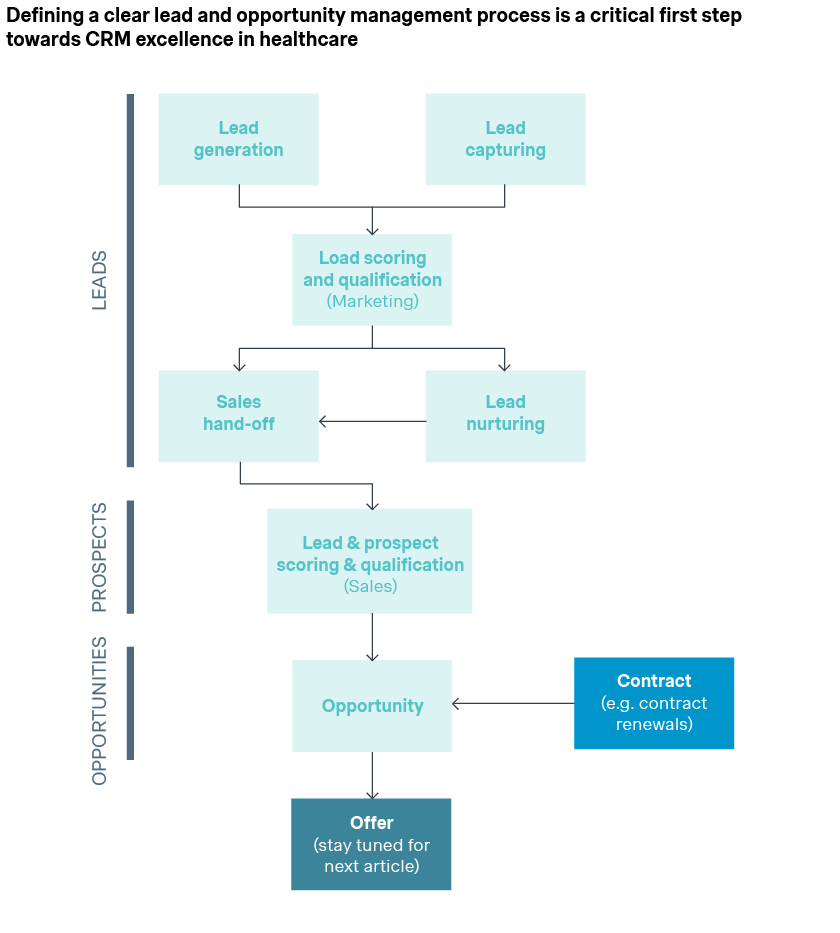
Lead management
Lead management involves the systematic process of capturing, tracking, and nurturing potential customers. It is typically owned by marketing teams and ends with a sales hand-off.
Effective management of leads ensures a steady influx of opportunities into the sales pipeline. This involves the use of Marketing Automation suites (MA) and Customer Relationship Management systems (CRM) to collect and organize lead data. Integrating lead management within a RMS allows businesses to categorize and prioritize leads based on their potential value.
By analyzing lead behavior, preferences, and engagement, organizations can tailor their sales strategies to better address customer needs.
Prospect management
After the marketing team has sufficiently nurtured the leads, they are transferred to the sales team (sales hand-off) for continued nurturing. This involves more targeted communication with potential customers.
The goal is to engage in an opportunity with the prospect, meaning a concrete possibility for sales.
Opportunity management
Opportunity management goes beyond the sales process by prioritizing qualified prospects with high conversion potential. This phase involves evaluating the likelihood of closing a deal, understanding customer requirements, and tailoring offerings to match those needs.
Within the RMS framework, opportunity management facilitates a targeted approach to sales. Sales teams allocate resources more effectively, directing efforts to high-value opportunities that align with the organization's overall revenue and profitability goals.
Use case: Lead scoring and lead grading
A key challenge that the medtech and diagnostics sales reps come across today is limited face-to-face time with healthcare buyers. Sales teams have a growing expectation to move online or to a hybrid model. As such, it is crucial to engage with leads across channels and accurately identify the leads worth engaging with.
In a recent Simon-Kucher study with healthcare companies, we learned that efficient targeting is one of the top 3 levers of achieving sales targets, besides segmentation and key account management. But how does the salesperson know which leads to focus on? Commercial teams use lead scoring and grading for effective targeting and revenue management goals.
Lead scoring is a systematic method of ranking leads based on their likelihood to convert into customers. It involves assigning numerical scores to various behaviors of leads, such as engagement level, past interactions, and purchasing intent.
Lead grading evaluates how closely a lead matches the ideal customer profile based on specific criteria important to the business, such as industry, company size, or job title. It assigns a grade based on how well a lead’s attributes match the company’s target market criteria.
Both work together to prioritize leads and allocate resources efficiently, focusing efforts on high potential leads that are best aligned with the company’s strategic goals.
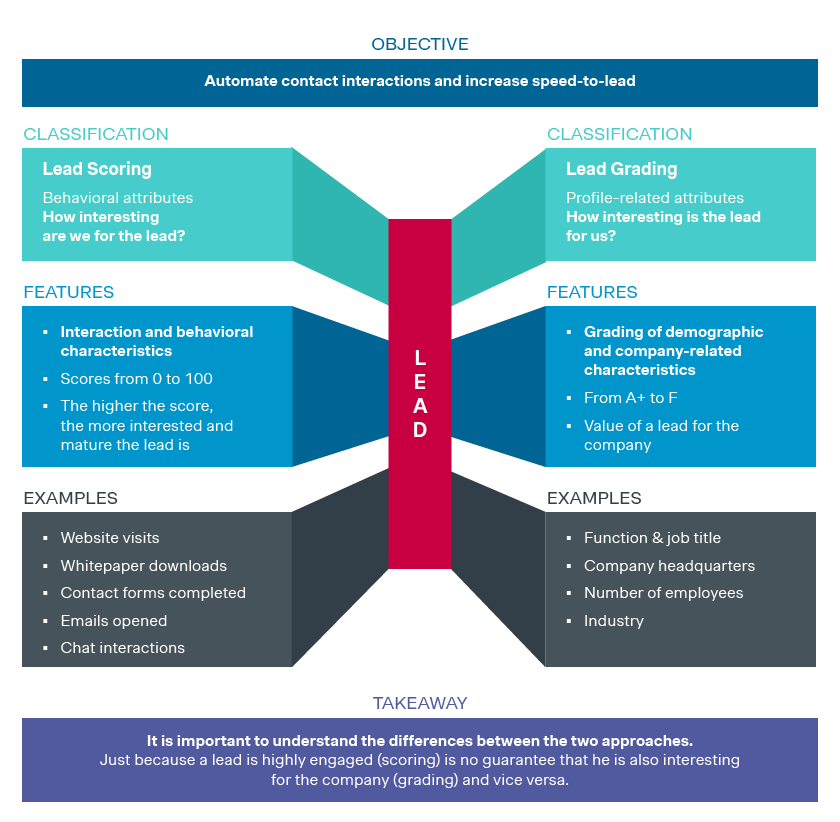
There are three main dimensions that we consider when scoring and grading a lead:
- Lead behaviors for lead scoring: The past actions of the lead provide insights into their interest in the products being offered. Engagement levels and past interactions are good indications of purchase intent. An example would be a target opening or clicking through the links within a marketing campaign email. Follow up with such a lead through tailored offerings. The more the lead engages with you, the higher the likelihood of purchase.
- Lead attributes for lead grading: These are a lead’s intrinsic characteristics. Demographics is a good example of a lead attribute — if someone is selling a $150k device, it may make sense to prioritize leads with a large enough budget (or revenue, as a proxy).
- Lead negatives for lead grading and scoring: It is important to track characteristics or behaviors that would suggest low purchase likelihood. In the example above, if someone unsubscribes from the marketing campaign email, it would be wise to not follow up (in the near future, at least).
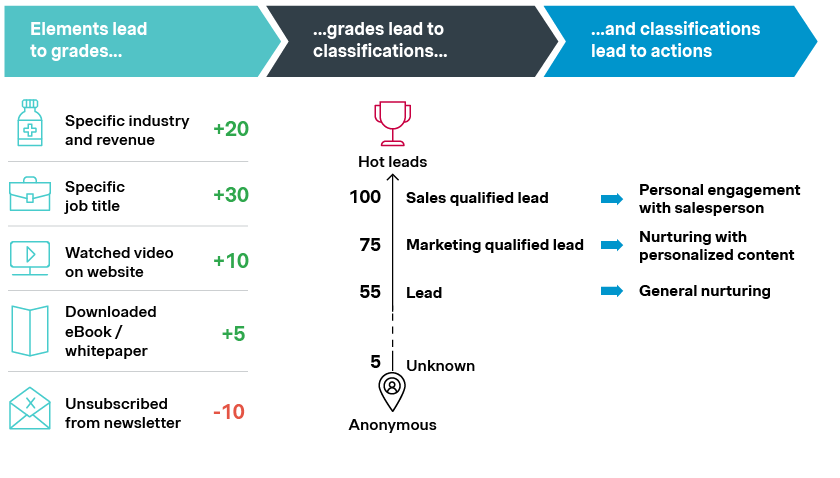
What about contracted revenue?
In the medtech and diagnostics sectors, a significant portion of revenue is derived from contracted agreements, which diminishes the traditional need for lead management. Instead, the focus shifts towards managing and renewing existing contracts, as most prospects are repeat clients rather than new leads.
However, the challenges are similar to those in classical lead management: limited resources and a lack of structured processes to effectively prioritize contract renewals. To address this, we propose adopting a typical lead management approach for use in contract renewals.
The focus is on establishing a scoring model that applies to contract renewals with existing clients, not new leads. While the approach is the same, the scoring criteria will need to change. Simon-Kucher has had success with some of the criteria listed below, but these must be customized to each individual case.
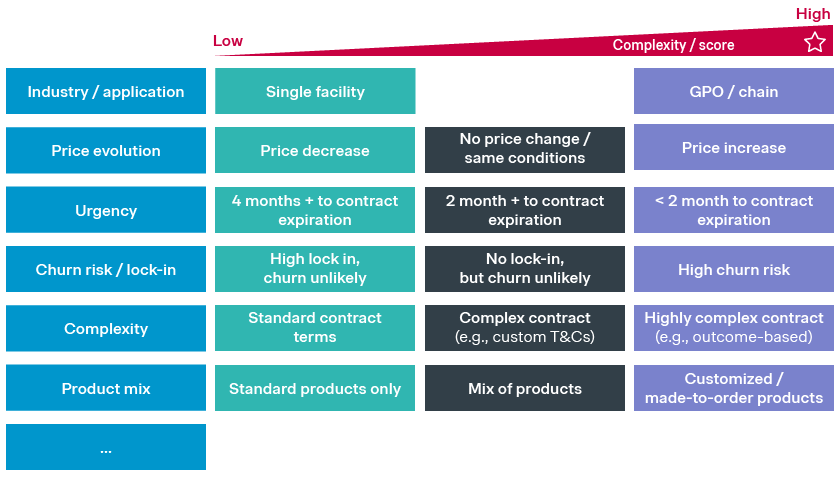
By applying this model, contracts can be sorted by score and routed to ensure that the most critical renewals are handled by senior personnel. This approach not only optimizes resource allocation but also ensures that high-priority contracts receive the attention they deserve. This strategy is equally effective for managing tenders.
But what about missing data?
Clients often ask how to build a trusted lead scoring and grading tool without consistent data. The key to effective lead scoring and grading is to design an algorithm that evolves and does not highly rely on having all attributes, behaviors, and negatives at the same time. This flexible tool efficiently uses existing data and seamlessly integrates new data from different source channels.
Which systems are typically used in lead and opportunity management?
As briefly mentioned above, two main categories of systems support in the opportunity phase:
- Marketing automation suites (MA)
- Customer relationship management applications (CRM)
Both serve a different purpose in the E2E RMS process. We present a short primer in the table below. However, capabilities spill across boundaries of categories with vendors constantly adding additional functionalities.
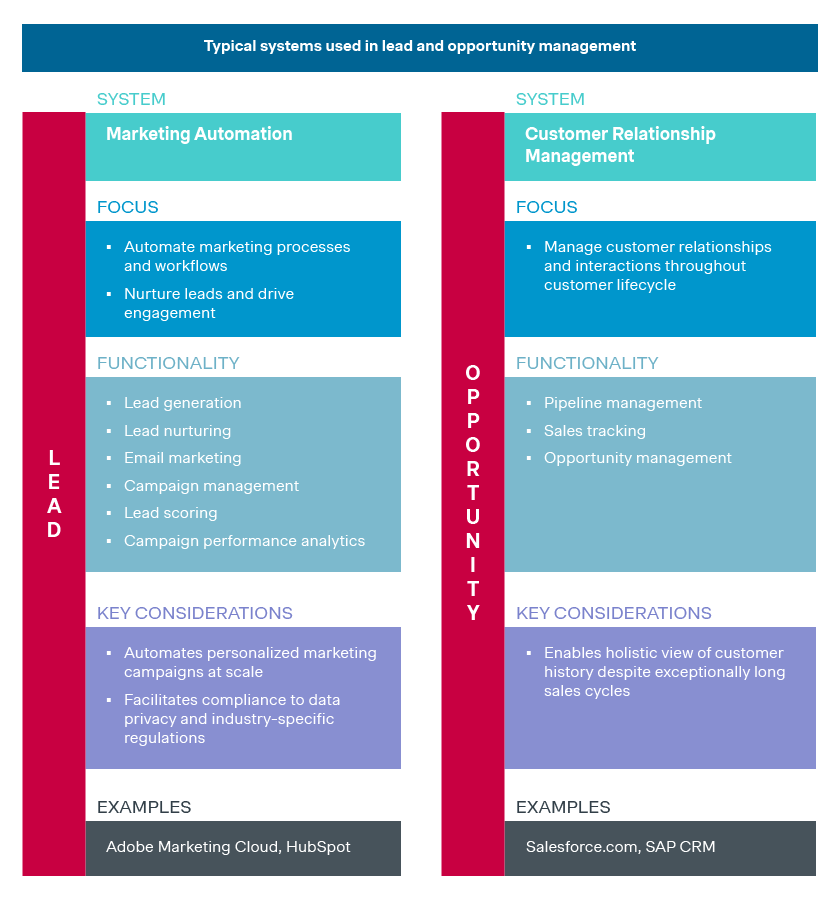
At the core of the entire E2E RMS journey stands the humble CRM system that serves as an end-to-end customer journey support tool. Here, all data and customer touchpoints are fully integrated and can be managed from one application (e.g., leads from MA are automatically converted into opportunities in CRM, salespeople launch a CPQ-based configurator from said CRM opportunity, and so on).
Overcoming challenges in achieving CRM excellence
Most companies fail to effectively maximize the benefits of a CRM and fulfill their key growth objectives because of a poorly implemented CRM as part of an E2E RMS. Based on Simon-Kucher benchmarks, about 30% of all CRM projects fail and another 40% have serious weaknesses because they lack a solid CRM concept.
In many client situations, we encounter a lack of systematic analysis of business user requirements. This occurs because future users are not involved in the project early on. Secondary priorities like vendor standard or IT roadmap overshadow conceptual elements such as customer segmentation approach and implementation of key insights.
Many organizations attempt to balance the benefits of a customized CRM with the advantage of a standardized solution, but often struggle to succeed. A well-defined CRM concept is vital for successfully implementing a solution that satisfies organizational needs and goals.
Identifying focal points (key areas and priorities to ensure robust implementation of a CRM system) as part of the CRM strategy is crucial for meeting customer and stakeholder expectations. A combination of these focal points can be used to tailor the CRM strategy to match the customer’s needs.
To achieve CRM excellence, medtech and diagnostics companies need to rethink current perspectives on marketing and sales. For example, companies must prioritize customer lifetime value over traditional objectives.
B2B scenarios require understating individual preferences and requirements through customer 360 view. Multi-channel management and price differentiation based on customer value lead to excellent customer relationships.
Who are the people involved and which skills are required?
Medtech and diagnostics companies have long been engaged in implicit lead management. A strategic augmentation of workforce skills can help implement refined processes such as explicit lead scoring and systematic lead nurturing.
The Simon-Kucher approach focuses on integrating essential skills for effective process implementation, rather than advocating for a complete overhaul of existing sales operations. Our experience reveals several key roles required for successful lead and opportunity management in medtech and diagnostics:
- Marketing automation specialists: They set up, drive, and operate lead management and nurturing processes through MA platforms.
- Sales development experts/reps: They progress leads from Marketing Qualified Leads (MQL) to Sales Qualified Leads (SQL) stages through targeted engagement strategies.
- Lead scoring scientists: They develop and implement sophisticated lead and opportunity scoring models to prioritize high-value prospects.
- Sales performance monitoring experts: They track the performance of lead and opportunity management operations to identify areas for improvement.
- System administrators: They bring together MA, CRM, and other E2E RMS systems to facilitate smooth data flow and information exchange.
In addition to the technical aspects, it is essential to bridge the gap between marketing and sales departments. For a seamless connection between systems, it is crucial to align departments, especially at critical junctures like the sales hand-off. Medtech and diagnostics companies can maximize their revenue potential and improve customer experiences by establishing interfaces between marketing and sales.
What is the key to success for medtech and diagnostics companies?
Lead and opportunity management in the medtech and diagnostics industry presents unique challenges and considerations. Understanding these distinctions is paramount for companies to steer their sales and marketing strategies. Here is why the medtech and diagnostics landscape stands apart:
Contracted revenue dynamics:
A sizable portion of revenue opportunities in this industry stems from existing clients and contracted agreements. Given the limited market size and high customer retention rates, extending lead management practices to contract renewals (and tenders) becomes crucial.Closed-loop feedback ensures that contract renewals are handled alongside new leads, promoting efficient resource allocation and optimal customer relationship management.
Extended sales cycles and lead capturing periods:
Medtech and diagnostics sales cycles are notably longer than those in other industries. This elongated process stems from complex decision-making structures within healthcare organizations and the need for extensive product evaluations.Consequently, extended lead capturing periods demand sustained prospect nurturing throughout the sales funnel.
Clinical and economic validation requirements:
Clinical and economic validation play a crucial role in the quoting and proposal stages. Prospects often require extensive evidence of a product's efficacy, safety, and cost-effectiveness before committing to a purchase.Lead management strategies must ensure that prospects receive the necessary information and assurances to progress through the sales pipeline. This includes providing comprehensive data on clinical outcomes and economic benefits, demonstrating the overall value proposition of the product.
Specialist knowledge requirements:
Medtech and diagnostics sales teams require specialized expertise given the technical and clinical nature of products and the intricacies of the healthcare landscape. Recruiting individuals with proficiency in lead scoring and broader life sciences knowledge may prove challenging, as the pool of suitable candidates is limited.Training and development programs are essential for equipping sales teams with the necessary skills and knowledge.
Optimizing lead and opportunity management for long-term growth with Simon-Kucher
Developing a successful end-to-end revenue management system can drive sustainable growth and profitability in your organization. At the same time, the importance of a properly designed, well-integrated lead and opportunity management cannot be overstated.
At Simon-Kucher, we acknowledge the interplay of people, processes, and systems as well as understanding the unique requirements and considerations of lead and opportunity management within the medtech and diagnostics sector. Our dedicated experts with over 20 years of experience empower companies like yours to find success in optimizing revenue management and accelerating growth.
Contact us to learn more about best practices on lead and opportunity management and how Simon-Kucher can help your organization drive price excellence and unlock sustainable growth in a dynamic market.
Stay tuned for more to come on Revenue Management Systems.






